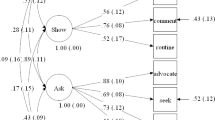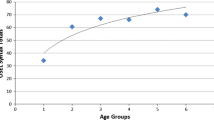Abstract
Thirty children with autism were observed during their everyday school activities in order to examine patterns of spontaneous communication. The forms, functions, and targets of their communication were recorded by trained observers. The prototypical communicative event consisted of a child directing a motoric form of communication toward the teacher to request something or to attract attention to himself or herself. However, communication patterns were found to vary as a function of the child's cognitive level and severity of autism. Deficits in joint attention functions were observed, and were most striking in the subgroup of children who did not use speech. Results are discussed with reference to Wetherby's (1986) model for the development of communicative functions in autistic children.
Similar content being viewed by others
References
Alpern, G., Boll, T. J., & Shearer, M. (1982).Developmental profile II. Aspen, CO: Psychological Developmental Corp.
American Psychiatric Association. (1987).Diagnostic and statistical manual of mental disorders—revised (3rd ed. rev.). Washington, DC: Author.
Bernard-Opitz, V. (1982). Pragmatic analysis of the communicative behavior of an autistic child.Journal of Speech and Hearing Disorders, 47, 99–109.
Cantwell, D., Baker, L., & Rutter, M. (1978). A comparative study of infantile autism and specific developmental receptive language disorder-IV. Analysis of syntax and language function.Journal of Child Psychology and Psychiatry, 19, 351–362.
Cunningham, M. A. (1966). A five-year study of the language of an autistic child.Journal of Child Psychology and Psychiatry, 7, 143–154.
Landry, S. H., & Loveland, K. A. (1988). Communication behaviors in autism and developental language delay.Journal of Child Psychology and Psychiatry and Allied Disciplines, 29, 621–634.
Landry, S. H., & Loveland, K. A. (1989). The effect of social context on the functional communication skills of autistic children.Journal of Autism and Developmental Disorders, 19, 283–299.
Leiter, R. G. (1980).Leiter International Performance Scale. Los Angeles: Western Psychological Services.
Loveland, K. A., & Landry, S. H. (1986). Joint attention and language in autism and developmental language delay.Journal of Autism and Developmental Disorders, 16, 335–349.
Loveland, K. A., Landry, S. H., Hughes, S. O., Hall, S. K., & McEvoy, R. E. (1988). Speech acts and the pragmatic deficits of autism.Journal of Speech and Hearing Research, 31, 593–604.
Marcus, L. M. (1978). Developmental assessment as a basis for planning educational programs for autistic children.Behavioral Disorders, 3, 219–226.
McHale, S., Simeonsson, R., Marcus, L., & Olley, J. (1980). The social and symbolic quality of autistic children's communication.Journal of Autism and Developmental Disorders, 10, 299–310.
Mesibov, G. B. (1988). Diagnosis and assessment of autistic adolescents and adults. In E. Schopler & G. B. Mesibov (Eds.),Diagnosis and assessment in autism (pp. 227–238). New York: Plenum Press.
Morgan, S. (1988). Diagnostic assessment of autism: A review of objective scales.Journal of Psychoeducational Assessment, 6, 139–151.
Mundy, P., & Sigman, M. (1989). Specifying the nature of the social impairment in autism. In G. Dawson (Ed.),Autism: Nature, diagnosis, and treatment (pp. 3–21). New York: Guilford.
Mundy, P., Sigman, M., Ungerer, J., & Sherman, T. (1986). Defining the social deficits of autism: The contribution of non-verbal communication measures.Journal of Child Psychology and Psychiatry, 27, 657–669.
Mundy, P., Sigman, M., Ungerer, J., & Sherman, T. (1987). Nonverbal communication and play correlates of language development in autistic children.Journal of Autism and Developmental Disorders, 17, 349–364.
Olley, J. G. (1985). Social aspects of communication in children with autism. In E. Schopler & G. B. Mesibov (Eds.),Communication problems in autism (pp. 311–328). New York: Plenum Press.
Paul, R. (1987). Communication. In D. J. Cohen & A. M. Donnellan (Eds.),Handbook of autism and pervasive developmental disorders (pp. 61–84). Silver Spring, MD: Winston.
Prizant, B. M., & Duchan, J. F. (1981). The functions of immediate echolalia in autistic children.Journal of Speech and Hearing Disorders, 46, 241–249.
Prizant, B. M., & Rydell, P. J. (1984). Analysis of functions of delayed echolalia in autistic children.Journal of Speech and Hearing Research, 27, 183–192.
Prizant, B. M., & Schuler, A. L. (1987). Facilitating communication: Theoretical foundations. In D. J. Cohen & A. M. Donnellan (Eds.),Handbook of autism and pervasive developmental disorders (pp. 289–300). Silver Spring, MD: Winston.
Prizant, B. M., & Wetherby, A. M. (1985). Intentional communicative behavior of children with autism: Theoretical and practical issues.Australian Journal of Human Communication Disorders, 13, 21–59.
Prizant, B. M., & Wetherby, A. M. (1987). Communicative intent: A framework for understanding socio-communicative behavior in autism.Journal of the American Academy of Child and Adolescent Psychiatry, 26, 472–479.
Ricks, D. M., & Wing, L. (1975). Language, communication, and the use of symbols in normal and autistic children.Journal of Autism and Childhood Schizophrenia, 5, 191–221.
Rutter, M. (1978). Diagnosis and definition of childhood autism.Journal of Autism and Developmental Disorders, 8, 139–161.
Schopler, E., Reichler, R. J., & Renner, B. R. (1988).The Childhood Autism Rating Scale. Los Angeles: Western Psychological Services.
Sigman, M., Mundy, P., Sherman, T., & Ungerer, J. (1986). Social interactions of autistic, mentally retarded and normal children and their caregivers.Journal of Child Psychology and Psychiatry, 27, 647–656.
Stutsman, R. (1948).Guide for administering the Merrill-Palmer Scale of Mental Tests. Chicago: Stoelting.
Tager-Flusberg, H. (1981). On the nature of linguistic functioning in early infantile autism.Journal of Autism and Developmental Disorders, 11, 45–55.
Tager-Flusberg, H. (1985). Psycholinguistic approaches to language and communication in autism. In E. Schopler & G. B. Mesibov (Eds.),Communication problems in autism (pp. 69–87). New York: Plenum Press.
Watson, L. D. (1985). The TEACCH communication curriculum. In E. Schopler, & G. B. Mesibov,Communication problems in autism (pp. 187–206). New York: Plenum Press.
Watson, L., Lord, C., Schaffer, B., & Schopler, E. (1989).Teaching spontaneous communication to autistic and developmentally handicapped children. New York: Irvington.
Wetherby, A. M. (1986). Ontogeny of communicative functions in autism.Journal of Autism and Developmental Disorders, 16, 295–316.
Wetherby, A. M., & Prutting, C. A. (1984). Profiles of communicative and cognitive-social abilities in autistic children.Journal of Speech and Hearing Research, 27, 364–377.
Wetherby, A. M., Yonclas, D. G., & Bryan, A. A. (1989). Communicative profiles of preschool children with handicaps: Implications for early identification.Journal of Speech and Hearing Disorders, 54, 148–158.
Author information
Authors and Affiliations
Additional information
The preparation of this manuscript was supported in part by the Florida Diagnostic and Learning Resources System (through a state general revenue appropriation for evaluation services in exceptional student education) and in part by NICHD grant # HD15052. The authors thank Eleanor Levine and Estelle Wild for their support of this project; Jennifer Rosenbaum, Pamela Fishel, and John Cosculluela for their invaluable assistance; and the participating classroom teachers for their time and cooperation.
Rights and permissions
About this article
Cite this article
Stone, W.L., Caro-Martinez, L.M. Naturalistic observations of spontaneous communication in autistic children. J Autism Dev Disord 20, 437–453 (1990). https://doi.org/10.1007/BF02216051
Issue Date:
DOI: https://doi.org/10.1007/BF02216051




